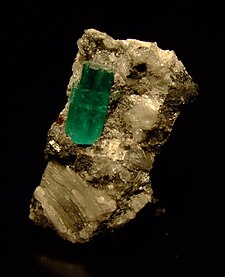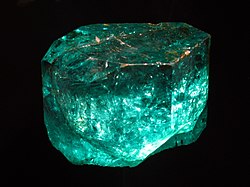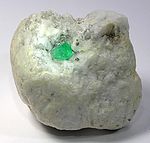Emerald
| Emerald | |
|---|---|

| |
| General | |
| Category | Beryl variety |
| Formula (repeating unit) | Be3Al2(SiO3)6 |
| Crystal symmetry | (6/m 2/m 2/m) – Dihexagonal Dipyramidal |
| Unit cell | a = 9.21 Å, c = 9.19 Å; Z = 2 |
| Identification | |
| Formula mass | 537.50 |
| Color | Green shades to colorless |
| Crystal habit | Massive to well Crystalline |
| Crystal system | Hexagonal (6/m 2/m 2/m)Space group: P6/mсc |
| Cleavage | Imperfect on the [0001] |
| Fracture | Conchoidal |
| Mohs scalehardness | 7.5–8 |
| Luster | Vitreous |
| Streak | White |
| Diaphaneity | Transparent to opaque |
| Specific gravity | Average 2.76 |
| Optical properties | Uniaxial (-) |
| Refractive index | nω = 1.564–1.595, nε = 1.568–1.602 |
| Birefringence | δ = 0.0040–0.0070 |
| Ultravioletfluorescence | None (some fracture filling materials used to improve emerald's clarity do fluoresce, but the stone itself does not) |
| References | [1] |
Emerald is a gemstone and a variety of the mineral beryl (Be3Al2(SiO3)6) colored green by trace amounts of chromium and sometimes vanadium.[2] Beryl has a hardness of 7.5–8 on the Mohs scale.[2] Most emeralds are highly included, so their toughness (resistance to breakage) is classified as generally poor. It is a cycosilicate.
Etymology[edit]
The word "Emerald" is derived (via Old French: Esmeraude and Middle English: Emeraude), from Vulgar Latin: Esmaralda/Esmaraldus, a variant of Latin Smaragdus, which originated in Greek: σμάραγδος (smaragdos; "green gem").[3]
Properties determining value[edit]
Emeralds, like all colored gemstones, are graded using four basic parameters–the four Cs of Connoisseurship: Color, Cut, Clarity and Carat weight. Before the 20th century, jewelers used the term water, as in "a gem of the finest water",[4] to express the combination of two qualities: color and clarity. Normally, in the grading of colored gemstones, color is by far the most important criterion. However, in the grading of emeralds, clarity is considered a close second. Both are necessary conditions. A fine emerald must possess not only a pure verdant green hue as described below, but also a high degree of transparency to be considered a top gem.[5]
In the 1960s, the American jewelry industry changed the definition of "emerald" to include the green vanadium-bearing beryl as emerald. As a result, vanadium emeralds purchased as emeralds in the United States are not recognized as such in the UK and Europe. In America, the distinction between traditional emeralds and the new vanadium kind is often reflected in the use of terms such as "Colombian Emerald".[6]
Color[edit]
In gemology,[7] color is divided into three components: hue, saturation and tone. Emeralds occur in hues ranging from yellow-green to blue-green, with the primary hue necessarily being green. Yellow and blue are the normal secondary hues found in emeralds. Only gems that are medium to dark in tone are considered emerald; light-toned gems are known instead by the species name green beryl. The finest emerald are approximately 75% tone on a scale where 0% tone would be colorless and 100% would be opaque black. In addition, a fine stone should be well saturated; the hue of an emerald should be bright (vivid). Gray is the normal saturation modifier or mask found in emerald; a grayish-green hue is a dull green hue.[5]
Emeralds are green by definition (the name is derived from the Ancient Greek word smaragdos, meaning green).[8] Emeralds are the green variety of beryl, a mineral which comes in many other colors that are sometimes also used as gems, such as blue aquamarine, yellow heliodor, pink morganite, red beryl or bixbite, not to be confused with bixbyite, and colorless goshenite.[9]
Clarity[edit]
Emerald tends to have numerous inclusions and surface breaking fissures. Unlike diamond, where the loupe standard, i.e. 10× magnification, is used to grade clarity, emerald is graded by eye. Thus, if an emerald has no visible inclusions to the eye (assuming normal visual acuity) it is considered flawless. Stones that lack surface breaking fissures are extremely rare and therefore almost all emeralds are treated ("oiled", see below) to enhance the apparent clarity. The inclusions and fissures within an emerald are sometime described as "Jardin" (French for 'garden'), because of their mossy appearance.[11] These imperfections within the stone are unique to each emerald and can be used to identify a particular stone. Eye-clean stones of a vivid primary green hue (as described above) with no more than 15% of any secondary hue or combination (either blue or yellow) of a medium-dark tone command the highest prices.[5] This relative crystal non-uniformity makes emeralds more likely than other gemstones to be cut into cabochons, rather than faceted shapes. Faceted Emeralds are most commonly given the Oval cut, or the signature Emerald cut, a rectangular cut with facets around the top edge.
Treatments[edit]
Most emeralds are oiled as part of the post-lapidary process, in order to fill in surface-reaching cracks, improving their clarity and stability. Cedar oil, having a similar refractive index, is often used in this generally accepted practice. Other liquids, including synthetic oils and polymers with refractive indexes close to that of emerald such as Opticon, are also used. These treatments are typically applied in a vacuum chamber under mild heat, to open the pores of the stone and allow the fracture-filling agent to be absorbed more effectively.[12] The U.S. Federal Trade Commission requires the disclosure of this treatment when an oil treated emerald is sold.[13] The use of oil is traditional and largely accepted by the gem trade, although oil treated emeralds are worth much less than un-treated emeralds of similar quality. Other treatments, for example the use of green-tinted oil, are not acceptable in the trade. Gems are graded on a four-step scale; none, minor, moderate and highly enhanced. These categories reflect levels of enhancement, not clarity. A gem graded none on the enhancement scale may still exhibit visible inclusions. Laboratories tend to apply these criteria differently. Some gem labs consider the mere presence of oil or polymers to constitute enhancement. Others may ignore traces of oil if the presence of the material does not materially improve the look of the gemstone.[citation needed]
Given that the vast majority of all emeralds are treated as described above, and the fact that two stones that appear visually similar may actually be quite far apart in treatment level and therefore in value, a consumer considering a purchase of an expensive emerald is well advised to insist upon a treatment report from a reputable gemological laboratory. All other factors being equal, a high quality emerald with moderate enhancement should cost much less than an identical stone graded none.[5]
Emerald mines[edit]
Emeralds in antiquity have been mined in Egypt since 1500 BCE, and India, and Austria since at least the 14th century CE.[15]
Colombia is by far the world's largest producer of emeralds, constituting 50–95% of the world production, with the number depending on the year, source and grade.[16][17][18][19] Emerald production in Colombia has increased drastically in the last decade, increasing by 78% from 2000 to 2010.[20] The three main emerald mining areas in Colombia are Muzo, Coscuez, and Chivor.[21] Rare 'trapiche' emeralds are found in Colombia, distinguished by a six-pointed radial pattern made of ray-like spokes of dark carbon impurities.[citation needed]
Zambia is the world's second biggest producer, with its Kafubu River area deposits (Kagem Mines) about 45 km (28 mi) southwest of Kitwe responsible for 20% of the world's production of gem quality stones in 2004.[22] In the first half of 2011 the Kagem mines produced 3.74 tons of emeralds.[23]
Emeralds are found all over the world in countries such as Afghanistan, Australia, Austria, Brazil,[24] Bulgaria, Cambodia, Canada, China, Egypt, Ethiopia, France, Germany, India, Italy, Kazakhstan, Madagascar, Mozambique, Namibia,Nigeria, Norway, Pakistan, Russia, Somalia, South Africa, Spain, Switzerland, Tanzania, United States(US), Zambia, and Zimbabwe.[1] In the US, emeralds have been found in Connecticut, Montana, Nevada, North Carolina, and South Carolina.[1] In Canada, in 1997 emeralds were discovered in the Yukon.[25]
Origin determinations[edit]
Since the onset of concerns regarding diamond origins, research has been conducted to determine if the mining location could be determined for an emerald already in circulation. Traditional research used qualitative guidelines such as an emerald’s color, style and quality of cutting, type of fracture filling, and/or the anthropological origins of the artifacts bearing the mineral to determine the emerald's mine location. More recent studies using energy dispersive X-ray spectroscopy methods have uncovered trace chemical element differences between emeralds; even emeralds mined within close proximity to one another. American gemologist David Cronin and his colleagues have extensively examined the chemical signatures of emeralds resulting from fluid dynamics and subtle precipitation mechanisms, and their research demonstrated the chemical homogeneity of emeralds from the same mining location and the statistical differences that exist between emeralds from different mining locations, including those between the three locations: Muzo, Coscuez, and Chivor, in Colombia, South America.[26]
Synthetic emerald[edit]
Both hydrothermal and flux-growth synthetics have been produced, and a method has been developed for producing an emerald overgrowth on colorless beryl. The first commercially successful emerald synthesis process was that of Carroll Chatham, likely involving a lithium vanadate flux process, as Chatham's emeralds do not have any water and contain traces of vanadate, molybdenum and vanadium.[verification needed] The other large producer of flux emeralds was Pierre GilsonSr., whose products have been on the market since 1964. Gilson's emeralds are usually grown on natural colorless beryl seeds, which are coated on both sides. Growth occurs at the rate of 1 mm per month, a typical seven-month growth run producing emerald crystals of 7 mm of thickness.[27] Gilson sold his production laboratory to a Japanese firm in the 1980s, but production has since ceased; so has Chatham's, after the 1989 San Francisco earthquake.[citation needed]
Hydrothermal synthetic emeralds have been attributed to IG Farben, Nacken, Tairus, and others, but the first satisfactory commercial product was that of Johann Lechleitner of Innsbruck, Austria, which appeared on the market in the 1960s. These stones were initially sold under the names "Emerita" and "Symeralds", and they were grown as a thin layer of emerald on top of natural colorless beryl stones. Although not much is known about the original process, it is assumed that Leichleitner emeralds were grown in acid conditions.[citation needed] Later, from 1965 to 1970, the Linde Division of Union Carbide produced completely synthetic emeralds by hydrothermal synthesis. According to their patents (attributable to E.M. Flanigen),[28] acidic conditions are essential to prevent the chromium (which is used as the colorant) from precipitating. Also, it is important that the silicon-containing nutrient be kept away from the other ingredients to prevent nucleation and confine growth to the seed crystals. Growth occurs by a diffusion-reaction process, assisted by convection. The largest producer of hydrothermal emeralds today is Tairus in Russia, which has succeeded in synthesizing emeralds with chemical composition similar to emeralds in alkaline deposits in Colombia, and whose products are thus known as “Colombian Created Emeralds” or “Tairus Created Emeralds”.[29] Luminescence in ultraviolet light is considered a supplementary test when making a natural vs. synthetic determination, as many, but not all, natural emeralds are inert to ultraviolet light. Many synthetics are also UV inert.[30]
Synthetic emeralds are often referred to as "created", as their chemical and gemological composition is the same as their natural counterparts. The U.S. Federal Trade Commission (FTC) has very strict regulations as to what can and what cannot be called "synthetic" stone. The FTC says: "§ 23.23(c) It is unfair or deceptive to use the word "laboratory-grown," "laboratory-created," "[manufacturer name]-created," or "synthetic" with the name of any natural stone to describe any industry product unless such industry product has essentially the same optical, physical, and chemical properties as the stone named."[13]
Emerald in different cultures, and emerald lore[edit]
Emerald is regarded as the traditional birthstone for May as well as the traditional gemstone for the astrological signs of Taurus, Gemini, and sometimes Cancer.[citation needed]
One of the quainter anecdotes about emeralds was told by the 16th-century historian Brantôme, who referred to the many impressive emeralds the Spanish under Cortez had brought back to Europe from Latin America. On one of Cortez's most notable emeralds he had the text engraved, Inter Natos Mulierum non sur-rexit mayor ("Among those born of woman there hath not arisen a greater," Matthew 11:11) which referred to John the Baptist. Brantôme considered engraving such a beautiful and simple product of nature sacrilegious and considered this act the cause for Cortez's loss of an extremely precious pearl (to which he dedicated a work, A beautiful and incomparable pearl), and even for the death of King Charles IX of France, who died soon afterward.[31]
The chief deity of India's most famous temple, the Madurai Minakshiamman temple, is goddess Minakshi, whose idol is made of emerald, most likely carved out of a single emerald stone.[citation needed]
Notable emeralds[edit]
| Emerald | Origin |
|---|---|
| Chalk Emerald | Colombia |
| Duke of Devonshire Emerald | |
| Gachala Emerald | |
| Mogul Mughal Emerald | |
| Patricia Emerald[32] Year 1920, 632 carats uncut, 12 sides-dihexagonal | Colombia |
| Bahia Emerald | Brazil |












Nenhum comentário:
Postar um comentário